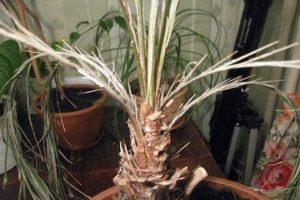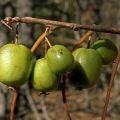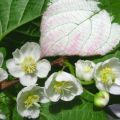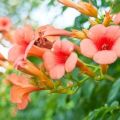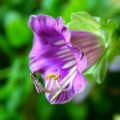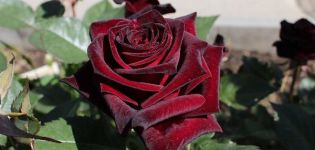Planting and caring for actinidia (kiwi) in a greenhouse, open field and at home, growing rules
In the deciduous forests of Primorye, in the subtropical latitudes of Asia and the island of Java, there is a plant that surprises with bizarre shoots, enchants with the beauty and aroma of white and pink flowers. Actinidia belongs to the most ancient cultures, it survived the Ice Age, therefore it adapted to low temperatures, and normally tolerates a sharp cold snap. Knowing the peculiarities of planting and caring for actinidia, a tree can be grown in a summer cottage or suburban area.
Content
- 1 Botanical description
- 2 How to tell a male from a female
- 3 Varieties of varieties
- 4 Reproduction methods
- 5 How to grow seedlings
- 6 Prerequisites for good growth
- 7 Technology and features of plant care
- 8 How kiwi reacts to improper care
- 9 When to wait for flowering and fruiting
- 10 Liana diseases and pests. Ways to deal with them
Botanical description
The name of the shrub vine from the Greek language is translated as a ray, in a similar way the columns on the ovary are located. The genus, of which Actinidia serves, unites up to 70 species. In the wild, the tree is found in the Himalayas. Clinging to branches, the liana rises almost 15 meters in height. Thin young shoots with a reddish tint are covered with shiny lenticels. Actinidia grows in both greenhouses and greenhouses, looks great as a hedge, but without support it does not even reach 2 meters.
The large leaves of the liana are a bit like a heart and differ in that they change color every season. In the spring they have a yellowish color, at the beginning of summer they acquire a green tint, during flowering the tips turn white, then pink and even crimson. Thanks to this phenomenon, actinidia looks unique. Buds are formed in leaf blades. Some plant species have snow-white corollas, while others have yellow or orange flowers and a delicate aroma.
Delicious actinidia grew in China, in Europe it began to be cultivated only at the end of the last century. The fruits of such a vine are sold in the market and are known to everyone as kiwi.
In mid-latitudes, a representative of the family is grown in summer cottages for decorative purposes, used as a flowering hedge. The fruit of frost-resistant varieties of deciduous liana is small in size, densely covered with hairs, not all fruits are eaten.
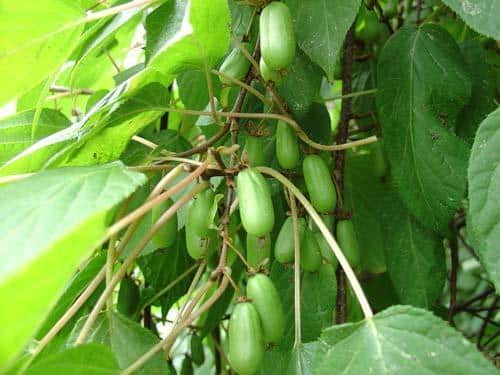
How to tell a male from a female
The dioecious actinidia has 2 types of flowers.When they first appear, it is possible to determine by the structure to which sex the tree or shrub belongs. A significant number of stamens and the absence of a pistil characterize the male liana, female specimens have it, and bees, wind, and wasps carry pollen to them.
Buds form in the leaf axils of young shoots, actinidia blooms for 10 days, an ovary forms on female plants, which eventually turns into yellowish or orange fruits.
The stamens of the flowers of male specimens have the ability to pollinate; it is from them that insects transfer pollen to female plants.To harvest fruits rich in ascorbic acid, you need to plant 2 liana trees nearby.
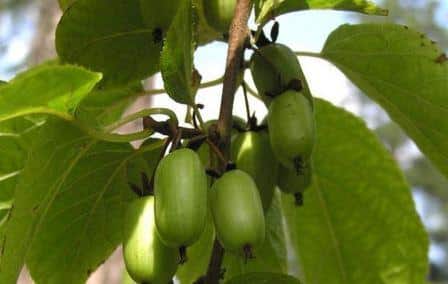
Varieties of varieties
Actinidia kolomikta found in fir and spruce forests of Primorye and Khabarovsk Territory, on the Kuril Islands and in China. Liana reaches a height of 8 meters, tolerates frosts of almost 40 ° C, green leaves turn white in summer, and turn pink by autumn. Even in the last century, thanks to Michurin's work, several varieties of perennial vines appeared. Large and tasty berries delight:
- Gummy;
- Waffle;
- Grape;
- Queen of the garden.
Trees are adapted to temperate climates, they feel normal in the open field, at a young age they give 3 kg of berries.
Actinidia pineapple arguta will grow 10 meters in height. Fruits of green color with a brown blush appear in the fourth year. They have a sweet and sour taste and delicate aroma.
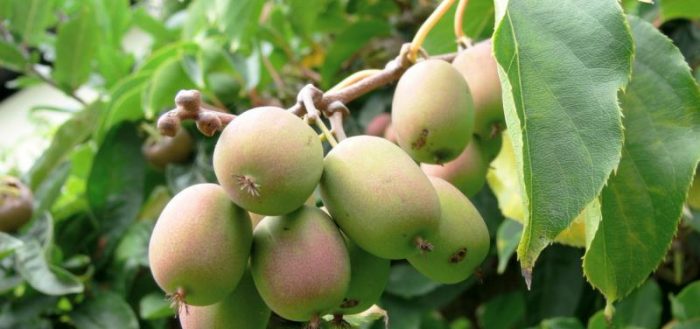
In mid-latitudes, gardeners grow:
- Vitacolu with cylindrical berries decorated with white stripes.
- Dr. Shimanovsky, the fruit combines the aroma of pineapple and apple.
- September - delighting with a good harvest of yellow-green fruits.
- Adam is a decorative vine with pink leaves.
Among the delicious variety of actinidia, Hayward is especially appreciated, the description of the berry attracted the attention of the inhabitants of the Mediterranean. In the south of Europe, in Israel, this variety is cultivated on an industrial scale, the Chinese gooseberry, as it is called, has taken root in the North Caucasus, in the Krasnodar Territory. A monoecious liana with a glossy surface does not require an additional pollinator, the buds gather in inflorescences up to 6 cm in diameter, white large petals have a pinkish tint. Oval fruits, weighing up to 150 g, are stored for almost 4 months, from one tree they collect from 7 to 9 buckets of delicate fruit.
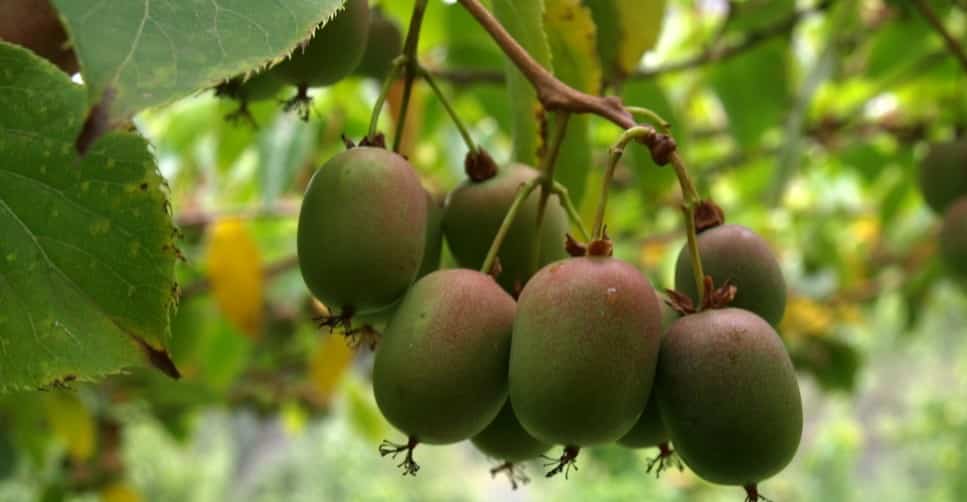
In the middle liana, liana is grown in a greenhouse and a room with good lighting, although it can withstand frosts of more than 25 degrees, it is cultivated only in closed ground.
For growing at home
For planting in the room, you need to select a low-growing actinidia, which will not take up much space. Liana takes root well in greenhouses, insulated loggias, where the air temperature does not drop below 7 ° C and the humidity is kept at the same level.
Varieties of Chinese actinidia grow normally in a pot or tub:
- Bruno;
- Abbot;
- Hayward;
- Monty.
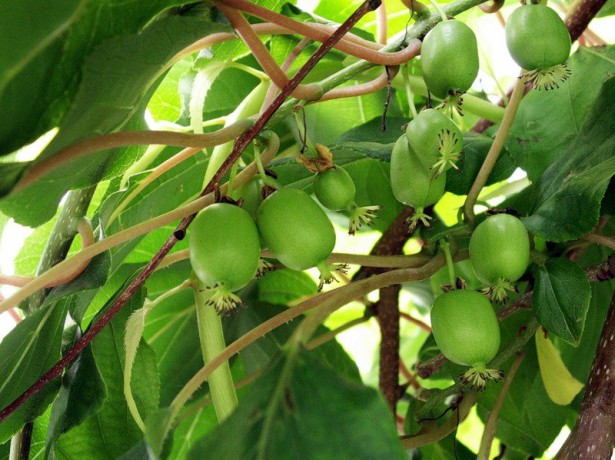
In order for the vine to delight with berries, you need to place 2 trees next to it - male and female. After they take root, you have to install supports.
In the open field
Although actinidia can grow in a pot, a full crop can be obtained by cultivating an overseas guest in the garden. In the middle lane, varieties of Kolomikta and Argut, bred by Moscow breeders, bear fruit:
- Queen of the garden. Rarely sick, does not suffer from insects. Flower buds form in the axils of the yellow-green leaves. Up to a kilogram of olive-colored berries, smelling of pineapple, are harvested from the bush.
- University. Liana of medium height is resistant to frost, pleases with elongated fruits with delicate pulp and aroma reminiscent of strawberries. The green skin is decorated with white stripes.
- Gourmet. The tree is distinguished by reddish shoots, dark leaves.The sweet berry weighs about 4.5 grams. The variety has been cultivated since the late nineties.

In which areas can actinidia be planted
In the Krasnodar Territory and in the North Caucasus, the Chinese liana takes root and bears fruit. In the area of Sochi Hayward, Bruno is cultivated on an industrial scale, Tomuri is used for pollination. Kolomikta and arguta are planted in central Russia. In the Moscow region, in the Urals, summer residents grow decorative actinidia and the varieties Vafelnaya, Lakomka, Doctor Shimanovsky, which are adapted to the conditions of the local climate.
Reproduction methods
You can dilute an exotic liana on the site in several ways. The easiest way to do this is when there is already one plant. In the spring, the strongest shoot, located below, is pressed to the ground and covered with soil, leaving the end on the surface.
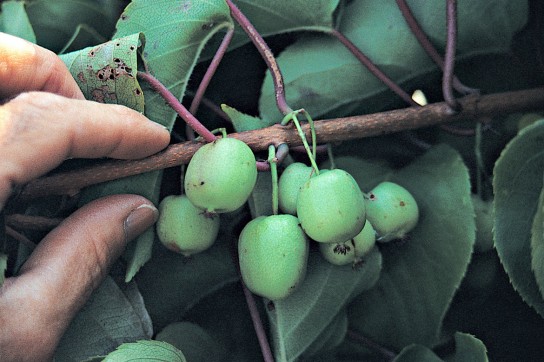
Cuttings
In the last days of July, they resort to a different breeding method. At this time, the fruits increase in size, the branches gain strength. Having chosen the strongest of them, they are shortened to a meter, the ends are placed in water. Shoots must have at least three buds for propagation with green cuttings to be successful.
First, the blanks are placed in a greenhouse, and only then they are grown in an open area. Gardeners who know how to inoculate actinidia enjoy sweet and sour fruits in a few years.
Seeds
Is it possible to breed a tropical liana in some other way, summer residents who do not have a plant to cut off the shoot are interested in. From the ripe fruits, you need to collect the seeds, peel the pulp and dry.
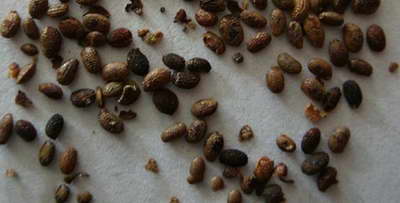
How to grow seedlings
Seeds sold in specialized retail outlets are usually stratified. If the grains are independently harvested from the berries of a subtropical liana, they must be hardened.
Preparing seeds for planting
At the end of autumn, the actinidia seeds are soaked for four days, constantly draining the water and collecting fresh water into a container with seeds. After drying, they are placed in a box with wet sand, left in the basement, and after 2 months they are transferred to a warm place to germinate.
Soil preparation
Vine seedlings do not take root in clay soil, do not tolerate stagnant water, and adore loose soil. At the bottom of the box, where the bones are placed, they put pebbles, which pass moisture well and serve as drainage, fill it with a mixture of turf soil, humus and sand.
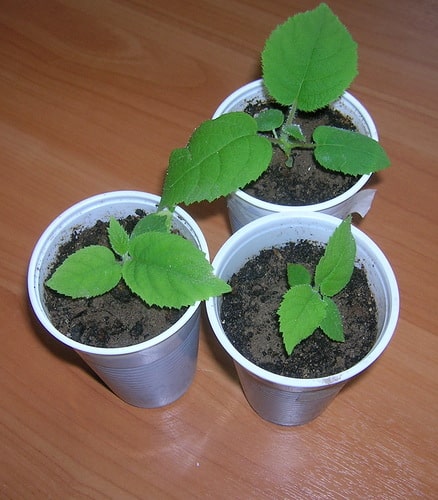
Planting germinated seeds in the ground
When 2 leaves appear on the seedlings, shallow grooves are made every 5 cm in the soil poured into the container, in which the germinated actinidia seeds must be planted very carefully. Vine bushes are sent to a permanent site in open ground at the age of not older than 2 years.
Prerequisites for good growth
In order for actinidia to develop, please with flowering and fruits, it is better to choose a place for it on a small hill, the site must be protected from northern winds.
Soil composition
Subtropical liana grows well on fertilized lands with a low level of acidity and on neutral soils, does not take root where water comes close to the surface, does not tolerate lime. When planting actinidia in a pit, a drainage layer must be made.
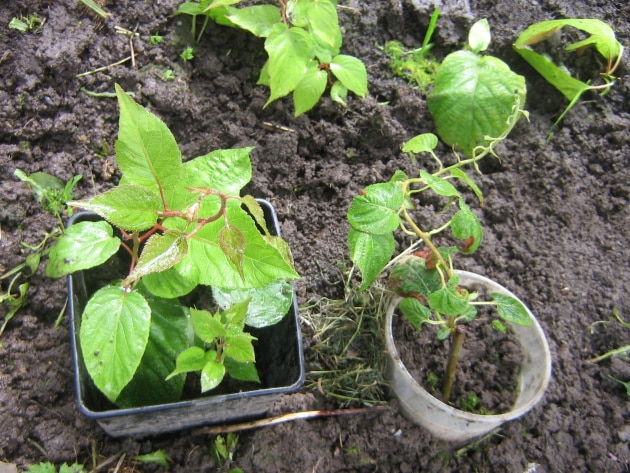
Temperature regime
Liana, bred specifically for growing in temperate climates, can withstand frosts up to 40 ° C, but young trees need to be covered with needles or leaves for the winter. The danger for actinidia is carried by negative temperatures in spring, at minus 8 kidneys die.
Lighting
In the wild, the vine grows in the partial shade of sparse forests. And although, like other subtropical cultures, it needs the sun, it is better to protect the tree from direct rays.
Technology and features of plant care
In order for actinidia to develop well, to please with fruits, it must be watered, fed, cut off.
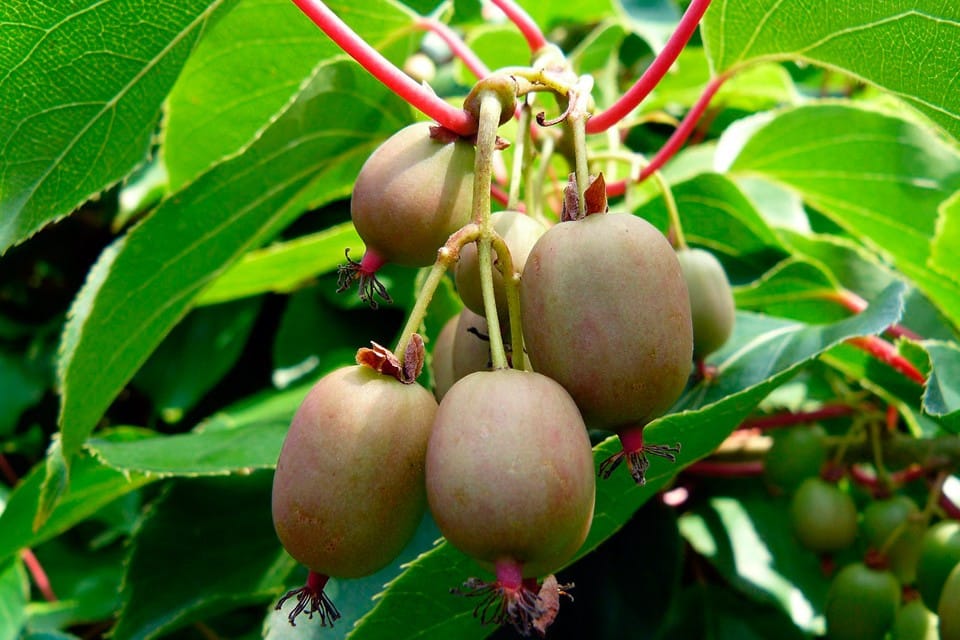
At home
Liana needs to be planted on a windowsill that faces south or west.The air must be humidified, otherwise the actinidia sheds its leaves, in the morning and in the evening the tree is sprayed with warm water. In winter and early spring, you need to ensure that he has enough light.
On open ground
In the middle latitudes in the country and in the garden, frost-resistant varieties of actinidia are cultivated. To provide the liana with moisture, once a week, 8 buckets of water are poured under each bush, after which the earth is loosened. Fertilizers are applied in the spring, before the ovary appears and in the fall. For foliar dressing use "Aquadon-Micro", "Immunofitofit". In order for the liana to cling to branches and rise, they put a support, pull the wire. If everything is done correctly, the plant takes on a decorative look.

In the greenhouse
In the middle lane, sprouted actinidia seedlings are not immediately transplanted into open ground, and in the northern regions, liana can only be grown in a heated greenhouse, where constant humidity, high temperature, good lighting are maintained, and top dressing is carried out regularly.
How kiwi reacts to improper care
With a lack of nutrients, which happens in the absence of timely feeding, the vine grows and develops poorly, and with an excess and with a lack of moisture, the tree drops its leaves and may die.
When to wait for flowering and fruiting
For dioecious actinidia to produce a crop, a male and female plant must be planted. If you create optimal conditions for development, carefully look after, liana produces flowers with large petals at the age of 3-4 years. In their place, a green ovary is formed. In autumn, in some summer cottages, you can see actinidia with small fruits.
Liana diseases and pests. Ways to deal with them
During a long drought, the actinidia growing in the garden is attacked by caterpillars, spider mites, which feed on the juice of the leaves, and gnaw the peel of berries. They fight them by spraying trees with insecticides. Liana is affected by powdery mildew and anthracnose. To protect actinidia from diseases, they resort to treatment with fungicides - "Radomil", "Switch", "Horus".
It is also necessary to fight against ground pests in the form of the May beetle and scoops, which damage the roots; the solution of "Aktara" is poured into the ground. For the destruction of weeds, herbicides such as "Roundup" are used.
